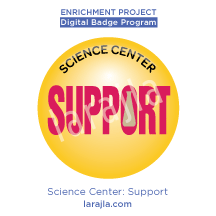 No matter how cost effective you attempt to make your Science Center, some costs will be involved. Your fundraising should reflect costs you cannot cover by donations and volunteers.
No matter how cost effective you attempt to make your Science Center, some costs will be involved. Your fundraising should reflect costs you cannot cover by donations and volunteers.
Steps
1. The plan.
Start with your plan. What exhibits do you want? What skills will be needed to make them possible? Who will you need to help? Continue asking yourself questions so you can make a list of the people, skills, space and materials you’ll need to make your Science Center a reality. This will give you information to back up your request for funds, volunteers, etc.
2. Fundraising reasons.
No matter how hard you try, you need money to repair exhibits, replenish materials and more. Before you decide on any one plan of action, look through the other steps of this badge program to determine what else you might provide that is unique to your Science Center and determine how much money you’ll need.
3. Donations and gifts.
If you’re working with organizations or groups, find out if they donate to projects such as this. You may need to meet certain requirements for donations, so read them carefully.
You can also request gifts. For example, International Friendship Gardens sent out letters to leaders in other countries requesting donations of bulbs and seeds to help start the garden. They received hundreds of tulip bulbs just by asking.
Gifts aren’t limited to physical items. Requesting a graphic designer to donate their time to design a logo, website or printed materials can save you a lot of money.
4. Grants.
Check out government agencies and local organizations that might help in the form of grants. If you know someone experienced in grant writing, they can be a big help. If not, find someone who can help you with the intricacies of this process.
5. Shop.
One way to cover costs is to have a shop to sell items. Check out the badge program “Science Center 04: Shop” for more ideas.
6. Snack area / cafe.
Providing fresh, healthy snacks and drinks is another way to provide a constant income stream. You might use items you grow as part of your exhibits or connect with local farmers. Brainstorm a list of healthy options you can offer.
NOTE: You can make your cafe open so that visitors can watch the food being prepared. You might even make a recipe book available for purchase for the healthy foods you choose to make.
7. Seeds and plants.
Selling seeds and seedlings for native and heritage plants might help you make a bit of money and / or create a sharing group to help minimize the cost of seeds. Part of your center could be dedicated to saving local plants this way.
8. Adult programs.
Another way to raise funds is to provide adult programming in the evenings. This gives the adults a chance to explore the center. You can also use this as a way to encourage the public to support it.
9. Rent it out.
You might rent out the entire facility for a special event or even specific exhibits that can go to troops or classrooms. Be sure to look into the pros and cons of renting out items, charging enough to cover damage, additional insurance and more.
10. Summer camp.
The idea of the Science Center is to have schools, teachers, youth groups and members all contribute to help create a place to explore during the school year. You have the entire summer free for camps, overnight programs and more. Is the possibility of hosting camps for the community available?
11. Holiday celebrations.
Special exhibits or presentations can draw in visitors. You might charge for the special exhibit and leave the rest of the center free. You might adjust your exhibits to reflect a holiday. How might you use the holiday to help your fundraising efforts?
12. Cultural identity.
Invite your community in for a cultural experience. From foods to music to handmade items, hosting a cultural event can bring in some revenue. What cultural elements can you use or adapt to help your Science Center?
Sites to Explore
To download a PDF of this badge program, click here: EP_SC05_Support
Leave a Reply